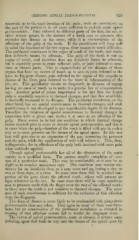Page 915 - My FlipBook
P. 915
CHRONIC APICAL PERICEMENTITIS. 925 ;
uncertain as to the exact location of the pain ; such an uncertainty on
the part of the patient is in all cases sufficient to exclude acute apical
pericementitis. Pain referred to different parts of the face, the ear, or
other remote points, in the absence of a tooth sore to pressure, also
excludes this disease as the cause, while it is characteristic of the
affections of the pulp of the tooth. If the practitioner will keep well
in mind the functions of the two organs, there cannot be much difficulty.
The peridental membrane is the organ of touch of the tooth, and there-
fore definitely locates its ailments. The pulp of the tooth is not an
organ of touch, and therefore does not definitely locate its ailments,
but is especially prone to cause reflected pain, or pain referred to asso-
ciate or distant parts. This is characteristic of the diseases of those
organs that have no nerves of touch, as is seen in pain referred to the
knee in hip-joint disease, pain referred to the region of the scapula in
disease of the liver, pain referred to the brow in inflammation of the
iris, etc. This peculiarity occurs so frequently in diseases of organs
having no sense of touch as to make it a general law^ of symptomatol-
ogy. Another point of prime importance is the fact that the dental
pulp is especially sensitive to thermal changes, and that this sensibility
is markedly increased in its diseases. The peridental membrane, on the
other hand, has no special sensitiveness to thermal changes, and such
sensitiveness is not developed to any considerable degree in its diseases.
Therefore the existence of special sensitiveness to thermal changes in
connection with a given case marks it at once as an affection of the
pulp. There seems to be but one condition in which thermal change
causes marked pain in acute or chronic apical pericementitis, and this is
in cases when the pulp-chamber of the tooth is filled with gas in such a
w;ay as to cause pressure on the tissues of the apical space. In this case
heat will give rise to an expansion of the gas, increasing the pressure
and the pain, while the application of cold will relieve it. This, then,
is diagnostic ; for in affections of the pulp both heat and cold cause pain
when suddenly applied.
Chronic apical pericementitis has all of the characters of the acute
variety in a modified form. The patient usually complains of sore-
ness of a particular tooth. This may be considerable, or it may be so
slight as to occasion annoyance only. This condition may remain sta-
tionary for an indefinite time, or it may come and go, lasting a day, or
two or three days, at a time. In some cases there will be marked con-
gestion of the gum about the affected tooth ; others will present no
signs whatever to the eye. In most cases there will be some sensitive-
ness to pressure made with the finger over the root of the affected tooth
in these cases the tooth is not sensitive to thermal changes. The pres-
ence of such sensitiveness is sufficient for the exclusion of this affection
from the diagnosis.
This form of disease is more likely to be confounded with phagedenic
pericementitis than any other. They agree in many of their manifesta-
tions, but an examination of the peridental membrane as directed in
treating of that affection cannot fail to render the diagnosis clear.
The CAUSE of apical pericementitis, acute or chronic, is always some
irritating agent that finds its way into the tissues of the apical space by


